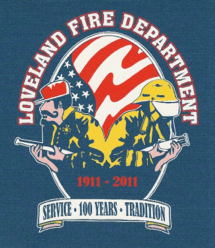 Thank you to Battalion Chief Rick Davis from the Loveland Fire Rescue Authority for sharing this article he wrote for Situational Awareness Matters. I had an opportunity to deliver a situational awareness program in Loveland for the North Range fire departments. When it comes to understanding the importance of firefighter situational awareness, Loveland Fire Rescue Authority really gets it!
Thank you to Battalion Chief Rick Davis from the Loveland Fire Rescue Authority for sharing this article he wrote for Situational Awareness Matters. I had an opportunity to deliver a situational awareness program in Loveland for the North Range fire departments. When it comes to understanding the importance of firefighter situational awareness, Loveland Fire Rescue Authority really gets it!
SA Matters to the Loveland Fire Rescue Authority
By Battalion Chief Rick Davis
In this article I will describe the importance of situational awareness (SA), rapid tactical decision making, and the efforts that have taken place at Loveland Fire Rescue over the past three years to improve our ability to safely conduct operations.
The Loveland Fire Rescue Authority (LFRA) protects approximately 88,000 people in 265 square miles of territory in southeastern Larimer County of Northern Colorado. LFRA is a three-tiered combination system comprised of 64 paid personnel (the chief, 57 in Suppression, and six in the Community Safety Division), 12 part-time firefighters, and 21 volunteer firefighters. In our system each volunteer is assigned to a shift and they are required to work a minimum of 36 hours per month at a fire station. Our area is comprised of suburban, retail, commercial, light manufacturing, wildland urban interface, and rural properties. Additionally there is a small airport, three rail lines, two U.S. highways, and an interstate that cross the jurisdiction.
For many years I have been interested in the decision making processes that occur in both the military and emergency services environment. However, it wasn’t until I was accepted into the National Fire Academy’s (NFA) Executive Fire Officer Program (EFOP) that I truly became a researcher and student of the topic. In early 2010 I submitted my first EFO research paper titled Making Rapid Tactical Decisions Under Stress. It was during this research project that I not only learned the true meaning of SA, but I was introduced to Dr. Gasaway through his book Fireground Command Decision Making.
My research revealed a tremendous misunderstanding of SA and rapid decision making inside the structural firefighting community. On the other hand, within the wildland firefighting arena there is not only a greater understanding of SA and rapid decision making, there are many classes taught on the subject and numerous articles have been written about both. Although we may use the term “fire service” as a generic catch-all in our profession, comparing the knowledge and understanding of SA and decision making between the two disciplines is truly like comparing apples and oranges. It is interesting to note that I am currently conducting research for my third year EFO project and it is about SA related to incident management teams. I am still finding the same inconsistencies and lack of understanding in the structural fire service as I did in my first research paper. I have a theory on why this disparity exists, but that is not the focus of this article.
Amongst other sources, my first year EFO research included the works of Dr. Gasaway, Gary Klein (recognition prime decision making and naturalistic decision making), Micah Endsley (SA Technologies), the U.S. Marine Corps, U.S. Navy, and Colonel John Boyd’s (USAF, Ret.) OODA Loop (which will be explained later). Endsley’s work not only defined SA, but she and her associates divided SA into three areas: perception, comprehension, and prediction. In his text, Dr. Gasaway expanded on this concept and his research revealed the top 12 barriers to command SA.
The work performed by these individuals and organizations was compared against that of Colonel Boyd. John Boyd was certainly a brilliant man, but he possessed many interesting and eccentric qualities. Those being what they were, Boyd developed the OODA Loop after many years of research. The OODA represents observe, orient, decide, and act. In the early 1960’s Boyd authored the Aerial Attack Study and as a graduate student at Georgia Tech he developed the Energy Maneuverability (EM) theory. The EM theory matched the technical data of U.S. and NATO aircraft against that of the Soviet Union, Warsaw Pact, and other enemy nations with the intent of being able to out-fly the opponent in combat. Both of Boyd’s studies had a profound impact on aerial warfare and how it was waged.
However, during the Vietnam War the United States was still losing pilots and aircraft to enemy forces. This led Boyd to conduct research into conventional warfare beginning with the ancient Chinese warrior Sun-Tzu. Boyd questioned why it was possible for numerically and/or technologically inferior forces to defeat larger and better equipped opponents. During his research he devoted a considerable amount of time to the German invasion of France, Luxemburg, and Belgium in May of 1940. That invasion led not only to the defeat of those respective armies, but also to the famous evacuation of the British Expeditionary Force from Dunkirk. I will describe more about May 1940 in later paragraphs.
Through his research, Boyd developed the OODA Loop. It was Boyd’s contention that an individual’s orientation was impacted by such things as training, education, heritage, culture, etc. A person’s orientation will in turn affect how they observe their environment. In other words, an individual’s situational awareness will impact their orientation and observations. The first two components of the loop, observation and orientation, will then naturally lead to a decision and action. It should be pointed out that Boyd initially developed the OODA Loop for use in the cockpit of jet fighters: a stress filled, fast paced environment where things take place within seconds.
Let’s return to May 1940 and ask the question, what happened? Simply put, the German’s out-thought, out-fought, and out-maneuvered the allied forces. The officers and non-commissioned officers (NCO’s) of the German army operated under the concept of commander’s intent. The U.S. Marine Corps Warfighting Manual describes commander’s intent as allowing “subordinates to exercise judgment and initiative – to depart from the original plan when the unforeseen occurs – in a way that is consistent with higher commander’s aims.” This is not the world of explicit orders, iron-fisted control, or micromanagers. This is the world of calm, professional, thinking individuals taking initiative based upon many things including perception, comprehension, and prediction of events: SITUATIONAL AWARENESS.
It is also the world of a well developed culture. In his book The German Way of War, Robert M. Citino explored the history of German warfare from Frederick the Great up through the end of World War II. What took place in Western Europe during May of 1940 was part of a culture of thinking, decision making, and warfare that began in the 1600’s. Please understand that this discussion is based on historical reality and in no way glorifies, justifies, or promotes the heinous crimes committed by the Nazi regime during World War II.
Every student that attends the EFO must write an applied research project (ARP) for each class and it must be submitted within six months of class completion. A part of each ARP is a section for recommendations. Based on the research I had conducted, one of my recommendations was to implement the OODA Loop for Loveland Fire Rescue. Several things were taking place at LFR during this time period including Chief Randy Mirowski pursuing a master’s degree. He too had developed an interest in SA and rapid decision making, but he also explored a concept called pentimento. Pentimento is seeing, seeing again, and seeing without seeing. This idea is applied many times in the art community when there is a picture within a picture.
While our research was taking place, LFR was involved in the final discussions to put into operation the Blue Card® Hazard Zone Command Training and Certification Program. The curriculum was ultimately implemented, but it was approached through a two-track system: (1) four classroom sessions on SA, rapid tactical decision making, the OODA Loop, High Reliability Organizations (HRO), Pentimento, and a case study on the Colerain Township, Ohio line of duty death incident and (2) the actual Blue Card® training consisting of online course work and hands-on training in the Command Training Center. Since 2010 LFR has certified all officers and acting officers in the organization.
SA matters, it matters to the members of the Loveland Fire Rescue Authority, and it should matter to you. Unfortunately it does not matter for many in our profession. I have attended two of Dr. Gasaway’s classes in the past year and a half and at lunch time I have seen far too many people walk out while they are making such absurd comments as: “I don’t need this, I’m not an officer, I don’t plan on being an officer, I’m not a chief, I want more hands-on classes”, and other asinine comments that aren’t worth repeating.
We must ask ourselves individually, organizationally, and as a profession this important question: “Do I/we really believe in firefighter safety or am I/we paying lip service to it?” At Loveland Fire Rescue we are committed to firefighter and civilian safety and a major part of this commitment is SA and the ability to make rapid tactical decisions under stress.
SA Matters to Loveland Fire Rescue
___________________________________________________________
The mission of Situational Awareness Matters is simple: Help first responders see the bad things coming… in time to change the outcome.
Safety begins with SA!
___________________________________________________________
I invite you to post comments to this article in the “Leave a Reply” box below.
If you want to send me incident pictures, videos or have an idea you’d like me to research and write about, contact me. I really enjoy getting feedback and supportive messages from fellow first responders. It gives me the energy to work harder for you.
Thanks,
Fire Chief (ret.) Richard B. Gasaway, PhD
www.RichGasaway.com
Email: Support@RichGasaway.com
Phone: 612-548-4424
Facebook: www.facebook.com/RichGasaway
Facebook Fan Page: www.facebook.com/SAMatters
LinkedIn: Rich Gasaway
Twitter: @RichGasaway
Twitter: @SAMatters
YouTube: RichGasaway1
YouTube: SAMattersTV
iTunes: SAMatters

